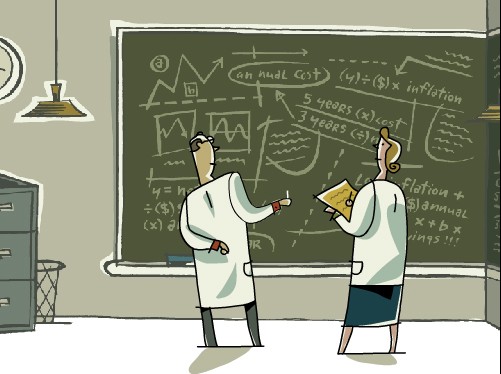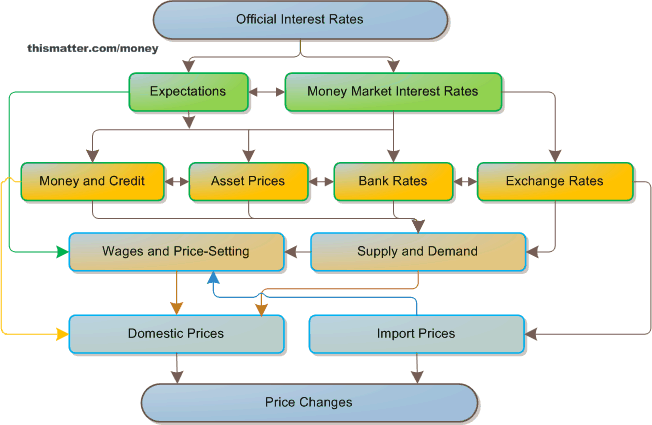Monetary Policy
Post on: 26 Май, 2015 No Comment

Monetary Policy
The Fed sets the money supply at M0.
The demand for money depends on how much of financial wealth one is willing to hold as money rather than in less liquid forms, i.e. bonds. This is a portfolio decision on the part of the economic agent.
What Affects Money Holdings ?
a) nominal interest rate . is the opportunity cost of holding money versus holding interest bearing assets. When i rises then the cost of holding dollars rises since the amount held in dollars could be earning a positive return in an interest bearing asset. So when i rises economic agents hold less money in their portfolio and hold more bonds.
b) general price level . when the price level rises more money is needed to make a given transaction, so people tend to increase their holdings of money when the price level rises.
c) level of real income . when individuals have more income they tend to hold more money as a store of value and to carry out more transactions using money.
DM is also known as the liquidity preference curve .
At ie people want to hold exactly the amount of money that is available.
When i >ie then the quantity of money supplied exceeds the quantity of money demanded so more money is in the economy than people want to hold and people try to buy bonds in order to decrease their money holdings. This drives up the price of bonds and leads to a fall in i .
How does the Fed affect the Money Market?
1) Increasing the money supply (expansionary policy occurs via buying bonds, reducing rr . or reducing the discount rate ). Any of these will shift the money supply schedule to the right and ie falls.
Decreasing the money supply via contractionary monetary policy will shift the money supply schedule to the left and will increase ie .
What if the price level rises? People will want to hold more money at any i . this will shift the money demand schedule to the right and i rises.
Monetary Policy and the Deflationary Gap
Q0 < Qp and the unemployment rate exceeds the natural rate of unemployment
If the Fed does nothing then the SRAS curve will move to the right once price expectations adjust to point A.
What is it that the Fed can do to get the economy out of the deflationary gap . If the Fed engages in activist monetary policy it can reduce unemployment and increase output, but how is this possible? How can the Fed do this? What are the steps in this process?
Above we learned that when the Fed increases the money supply . i falls. What are the effects on the economy of a fall in the nominal interest rate .
Remember on our last exam when the government borrowed to fund additional expenditures? The deficit increased and the government increased its presence in the market for loanable funds, increasing the demand for loanable funds and resulting in a higher interest rate. What effects did this change in the interest rate have on AD . Recall that the interest rate affects consumpion . investment . and net exports . When the interest rate rose, AD fell. So, when the Fed increases the supply of money and the interest rate falls, consumpion . investment . and net exports will rise, increasing AD .
Expansionary Monetary Policy
If the Fed pursues expansionary monetary policy by increasing the supply of money then the nominal interest rate will fall, investment will rise, consumption will rise.
- interest sensitive purchases are less expensive
- people save less and consume more
- because the supply of money rises, people buy more goods and services. As the business cycle expansion gets underway, wealth rises and people buy more financial assets as well.
the fall in the nominal interest rate will mean that net exports will rise since the value of the dollar will fall. Note that dollar denominated assets will have a lower return when the nominal interest rate falls and investors will no longer wish to hold as many dollar denominated assets as they did before. When investors unload their dollar denominated assets they take the dollars that they receive and purchase assets denominated in other currencies. When the value of the dollar falls exports are cheaper and imports are dearer. Thus net exports (X — M) must rise. By shifting AD to the right at point B the Fed returns the economy to potential output without waiting for expectations to adjust.
Inflationary Gap
If policy makers do nothing, price expectations will eventually adjust, shifting SRAS to the left, raising prices and wages.
Contractionary Monetary Policy
As the money supply is contracted, interest rates rise . investment will fall, consumption will fall and net exports will fall.
rising interest rates
Remember that people make a portfolio choice . How much do they wish to hold in the form of money and how much in bonds? People will choose to hold more bonds than they did before because the return on a bond has risen (i has gone up).
So, if the Fed pursues contractionary monetary policy by decreasing the supply of money . the nominal interest rate will rise, investment will fall, and consumption will fall.
All of these changes will shift the AD to the left and return output to Qp but without a price increase.
Problems in Implementation (similar to fiscal policy )
1) Recognition . Policy makers must know where Qp is to know which situation we are in. Also must now where the economy is now. Problem is the data that policy makers look at is old
2) Decision Lag . by the time policy is implemented economy may have changed; all statistics on the economy are ex post. One policy maker likened it to trying to drive a car with the frontwindshield and side windows blackened, with only the rearview mirror to see where the car has been, but not able to see where it is going.
There is much less of a time lag for monetary policy than fiscal policy. Once the Fed decides to act they can buy or sell bonds with a phone call to the trading desk.
3) Effectiveness Lag . takes 6 months to 2 years for a monetary change to have its full effect on the economy.
Could the Fed continually increase the money supply to increase AD and continually maintain output at a high level of output?
If the change in the money supply is unanticipated then
The unanticipated change in the money supply will shift the AD curve up and to the right but the SRAS curve is constant since no price expectations adjustments have occured as of yet. Note that ouput rises and so does the price level .
In the long-run . the SRAS curve will shift back and to the left raising the price level even more so and output will return to the potential level of output .
Summary in the short run an unanticipated change can increase output beyond the potential level of output . But, in the long run only the price level will rise and output will be at the potential level .
If there is an anticipated change in the supply of money

As AD shifts to the right, SRAS shifts to the left due to the full adjustment of price expectations . Thus output stays at Qp but the price level rises to P2 ..
In an inflationary period, workers build price changes into their contracts. (witness the 70нs)
In the Money Market
With an unanticipated increase in the money supply the nominal interest rate falls. But, real income rises due to the increase in the money supply so, the demand for money must also rise, a shift to the right. Thus, the interest rate still falls but not by as much as it would have fallen if income had not changed.
If the increase in the money supply is fully anticipated . then the demand for money rises by more than if the change had been unanticipated . (Again note that the demand for money shifts when there is a change in the price level . So when the price level rises the demand for money rises.) It may be possible to get no net change in the interest rate. Show this with a graph on your own.
If the Fed continually increases the MS . people begin to anticipate it (that is, they anticipate the inflation), and the price level . money demand and the nominal interest rate may all rise. Show this with a graph on your own.
Summary of the effects of increasing the money supply
1) tends to lower the nominal interest rate
2) if the increase in the money supply also increases inflation then the nominal interest rate rises which could offset the original fall in the interest rate or it could, if inflation was great enough, cause the nominal interest rate to rise even above the level it had before the increase in the money supply.
US evidence . nominal interest rate tends to move with the money supply .
Increasing the money supply does not necessarily cause inflation if there is economic growth . In this case LRAS is moving to the right which has a tendency to lower prices.
If the money supply increases at same rate as the economy is growing, expect stable prices.
monetary growth in excess of the rate of economic growth tends to cause inflation .
International Evidence
1) Higher money supply growth rates generally associated with high inflation
2) Higher money supply growth rates not associated with high GDP growth .
Consider the Latin American Experience 1986-1996
Hyperinflations
extremely high rates of inflation
Germany 1922-23:
Hungary 1945-46:
Bolivia 1983-84:
Bolivia had Britain and West Germany print currency for them currency imports were 3rd largest import.
Hyperinflation is associated with very high increases in the supply of money . Why?
a) government is in debt and tries to monetize the debt
- did not have independent central bank














